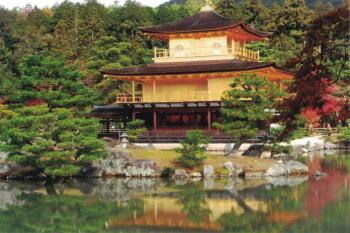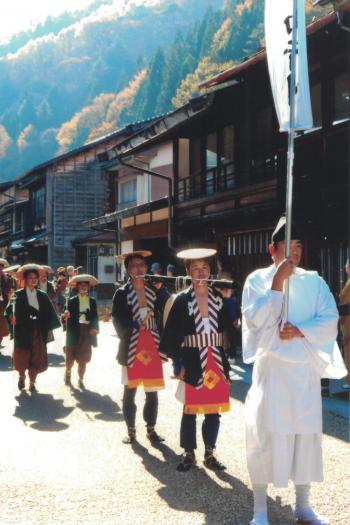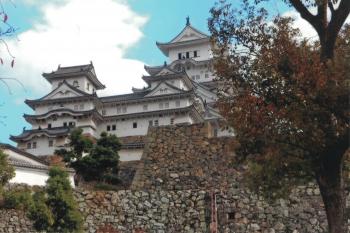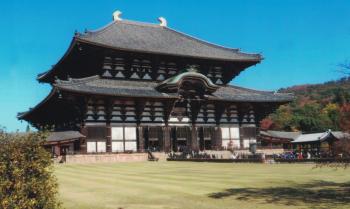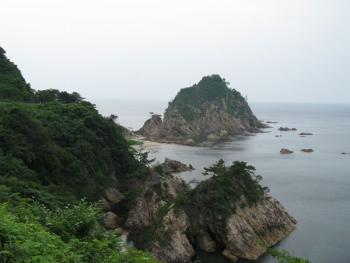Japan — an independent journey
This article appears on page 20 of the December 2018 issue.
After a 45-year hiatus, my husband, Phil, was eager to return to Japan, which had had a profound effect on him during a brief visit in 1972. And after a number of trips to other Asian countries, I was more than eager to visit it for the first time.
Our two-week trip began in early November 2017, a time we had chosen for typically good weather conditions and for the relatively few major holidays or festivals scheduled. However, as it was autumn-color time (magnificent), it drew crowds of visitors.
Planning a trip
Phil and I are experienced, independent, destination-oriented travelers and are honored to be members of ITN's Quarto Mondo (at least 49 countries) group. We custom-tailor our trips based on personal interests, which center on ancient traditions and culture, and we decide where to go, what to see and where to stay based on our own research, using multiple guide and history books, Internet searches and travel articles. ITN, to which we have subscribed for more than 30 years, has been an invaluable and reliable resource.
In Western countries where English is commonly spoken, we typically make our own arrangements. However, for visits to destinations with unfamiliar cultures (e.g., the Middle East, Asia, etc.), we sometimes rely on the guidance and coordination of US-based travel agents who have specialized, personal knowledge of the area and can oversee and coordinate any needed logistical arrangements. These agents have often provided valuable insights and recommendations, and such was the case with our 2017 trip to Japan.
We benefited from the very knowledgeable and experienced staff at Asian Pacific Adventures (Tarzana, CA; 800/825-1680, asianpacificadventures.com) and greatly appreciated the input, guidance and assistance of the owner, Hima Singh.
Tokyo on our own
Our trip began with a ride on Tokyo's high-speed Narita Express bullet train from the airport to Tokyo Station — our first experience with the superb Japanese rail system — which was easily accessed at the airport. This was the fastest and cheapest transportation option into the city (about $27 per person).
Tokyo Station was situated just a few blocks from our excellent 5-star accommodation, The Palace, which was centrally located in the business/financial district and overlooked the Imperial Palace gardens.
With the first afternoon set aside to recover from jet lag, we set out the next morning on our own to visit the National Museum, in Ueno Park, to tour its Gallery of Horyuji Treasures, with artifacts dating back to the 7th and 8th centuries. We also visited its Honkan Gallery of Art and the Heiseikan Archaeology Gallery. We highly recommend this museum as an orientation to, and grounding in, Japan's rich, ancient culture.
While walking to the nearby Toshogu Shrine and Five-Story Pagoda, we unexpectedly came upon a memorial that holds an eternal flame from Hiroshima and Nagasaki — once an expression of resentment but now a poignant expression of peace.
Next visited was Sensoji Temple, in the Asakusa district, Tokyo's oldest, most sacred and, arguably, most impressive Buddhist temple. Unfortunately, the temple and temple grounds were very crowded, making the experience somewhat less than optimal.
Also crowded was the nearby Nakamise shopping street, comprised of more than 150 small shops selling souvenirs, local crafts and fast food. But on a detour to an adjacent side street to get around the crowds, we discovered the Imahanbetsukan restaurant, where we enjoyed what turned out to be our only sukiyaki meal.
In the morning, we met Bodhi Fishman, who would be our guide for the duration of our trip. Bodhi had been described as a "Japan expert" but proved to be more of a "Japan master," deeply immersed in and dedicated to the study of the history and traditional arts of Japan. Simply put, Bodhi is one of the very best guides we have ever had, and we are deeply indebted to him and to Hima Singh for their help in making this one of our most memorable travel experiences.
Nikko
After a one-hour train trip, we arrived in Nikko, a major priority for us. A total of 103 religious buildings, belonging to two Shinto shrines and one Buddhist temple and covering 125 acres of the city, are designated as a UNESCO World Heritage Site.
Our first stop was the iconic, vermillion Shinkyo Bridge, where the blessing ceremony for a traditional Shinto wedding, led by a male priest and "shrine maiden," was under way — a rare occurrence, in Bodhi's experience.
We continued on to the Toshogu Shrine, begun in the 17th century by the grandson of the shogun Tokugawa Ieyasu. There, due to a 3-day weekend to celebrate Culture Day, crowds were prevalent. The site progressed from a series of stairs to the richly ornamented Yomeimon Gate, which led visitors through a vast series of gates to the much smaller and more subdued mortuary.
We also visited the Tamozawa Imperial Villa, a very interesting, serene and less-crowded site. The large villa was constructed of wood at the end of the 19th century and was used by three emperors and three princes as a retreat until 1947.
In Nikko, we stayed at the Okunoin Hotel Tokugawa, where room accommodations were Western in style but meals, traditional Japanese. There, we had our first kaiseki meal — a traditional, multicourse dinner — as well as a Japanese breakfast. (More on kaiseki later.)
Kiso Valley
Next we boarded the first of four trains for the 5-plus-hour trip to the Kiso Valley, where the goal was to walk several portions of the old Nakasendo Highway, a major route between Kyoto and Edo (now modern Tokyo) during the 18th and 19th centuries.
Our hotel for this 2-day stage of the journey was the excellent Hotel Fuki no Mori, outside of Nagiso, a modern, traditionally designed Japanese inn where we quickly adapted to ryokan etiquette — wearing a yukata (a light robe folded left over right) and removing shoes upon entering, wearing slippers thereafter — and proper bathing manners (washing and showering outside the tub before soaking).
We slept on futons placed on the floor, which was covered with tatami mats. We slept well, not withstanding pillows that were half beanbag, half feather filled.
Dinners were traditional Japanese kaiseki, a sophisticated, artistic and gracious Japanese cuisine comprised of fresh, seasonal (and often local) ingredients with the appearance, taste, texture and colors of each dish beautifully balanced.
A kaiseki meal can easily take two to three hours and typically includes a succession of courses (as many as 15), each with as many as eight or more small dishes designed to complement each other. Largely absent were the breads and sauces that are so prevalent in the West.
Breakfasts were similar, with 15 to 20 or more separate small dishes. Selections included miso soup, filleted fish, tofu skin, duck, ham, fish cake, vegetables, potato salad, fruit, rice and yogurt.
The next day, a short train ride took us to Narai-juku, a historic "post town" (a place for travelers to rest) on the Nakasendo Highway. Row houses along the narrow road displayed the unique building style of very old inns, characterized by gently sloping, overhanging roofs with eaves projecting over the lower story.
But before we began our walk, we were treated to a once-a-year rarity: a traditional Japanese costume parade reenacting the bridal procession that carried the Princess Kazunomiya from Kyoto to Edo for a marriage arranged by the Tokugawa shogunate in an effort to stabilize the country following the arrival of Commodore Perry in 1853, which ended Japan's policy of isolation from the outside world.
Through the forest
Following another traditional breakfast the next morning, we took a short train ride to Magome to begin a 5-mile hike to Tsumago. (Magome and Tsumago are two of the 11 old Kiso Valley post towns that still retain much of their Edo-period character.) Magome proved to be a good starting point because the walk to Tsumago, while arduous, was mostly downhill from there and, therefore, easier on the legs than walking in the reverse direction.
The wooden houses in Magome, though appearing to be ancient, are actually faithful reconstructions of those destroyed by fire in the late 19th century.
Shortly upon leaving town, we entered a vast forest and encountered the first of many signs warning of bears, posted together with bells for hikers to ring to scare them off. Since none were actually sighted, our bell-ringing must have been effective!
Our hike ended in Tsumago, where we had an excellent lunch of teppanyaki-style (cooked on an iron griddle) beef at the Fujioto Ryokan. Overall, the Kiso Valley trek was stunningly beautiful, with its views of deep chasms, tall stands of cypress and bamboo and dramatic waterfalls. This experience is highly recommended, if you have the stamina.
Later, we boarded a high-speed shinkansen train from Nagoya Station to Kyoto.
Japan's train system is simply extraordinary — clean and quiet, offering very frequent runs and, above all, almost always on time!
In all, we took 24 trains on this trip, with only one being late (by two minutes, and with an apology issued by the conductor)! Never did we encounter litter or grafitti.
Kyoto
The next stage of our journey began in Kyoto. Established in AD 794, it served as the imperial capital until 1868, when the capital was shifted to Edo (Tokyo). Kyoto served both as a destination in itself and as a hub for day trips south to Himeji and Nara.
Our hotel for four of our five nights there was the Westin Miyako Kyoto, a fairly large, conventional Western-style hotel that offered a respite from the ryokans and aforementioned beanbag pillows.
Fortunately, Kyoto survived the bombings of WWII, sparing its many ancient and important temples and shrines, but city sites have been rebuilt a number of times due to fire and earthquakes.
While in Kyoto, we were enormously privileged to visit the Imperial Zen Temple of Jiju-in for a private tour, led by the abbess, of the temple's extraordinary art treasures and gardens. The temple was originally constructed as a gift from an emperor to one of his favorite daughters, and it is closed to the public. However, Bodhi's special relationship with the abbess allowed us this unique and extraordinary experience.
Following our tour of the temple, we were hosted to an informal tea ceremony by the temple's tea master, Moriya Michiko, and a lesson in chabana (flower arranging) with the abbess and the temple's flower master.
That evening, we transferred from the Westin Miyako to the Hiiragiya Ryokan, one of the most famous ryokans in Japan and another highlight of our trip. We stayed in the original 200-year-old section in a 9-tatami-mat room with an alcove that overlooked a small private garden, also enjoying another extraordinary kaiseki meal. (FYI — ryokan rooms are measured by the number of tatami mats that can fit therein; in Kyoto, each mat measures approximately 3'2" x 6'3".)
Himeji
The next day Phil and I were on our own in Kyoto, as Bodhi needed to attend to some private business. We chose to visit the National Museum, a mistake on our part due to a special National Treasures exhibit that was featured there. It precluded admission to the museum's other attractions and drew massive crowds with interminable lines, but that was the only disappointing experience of the day.
Reuniting with Bodhi the following morning, we took the Shinkansen Hikari bullet train for an hour's ride to Himeji Castle, a UNESCO World Heritage Site and Japan's largest surviving castle. (I'll refer you to the July 2016 issue of ITN and the article "A Tale of Three Castles," page 54, for more information and insight on this site.)
After an excellent teppanyaki Kobe beef lunch at Kawamura, we returned to Kyoto to visit the Ginkaku-ji (Silver Pavilion), a former shogun's villa and the site of one of Kyoto's most beautiful and historically important gardens.
That evening, we had an extraordinarily memorable visit to the Miyagawa-cho neighborhood, one of the enclaves in Kyoto famous for having the most beautiful geishas.
There, in the waning light and quietude of the evening, we saw apprentice geishas (young girls, 15 to 20 years old, called maikos) hurrying down a narrow, lantern-lit street to meet the adult geishas for the evening and provide entertainment — typically, a Nihon buyo classical dance accompanied by music and singing — for clients. This is an honorable and highly esteemed profession in Japan that is often misunderstood in the West.
Nara
Founded in AD 710, Nara, next on our itinerary, was Japan's first political capital and cultural center. Our primary goal there was to visit Todai-ji Temple, arguably the most important Buddhist temple complex in Japan and another UNESCO World Heritage Site.
To get there, we walked from the train station through the deer park, and we do mean deer. Hundreds and hundreds of them roam freely, boldly accosting visitors to demand food.
The Todai-ji Temple is one of the world's largest wooden structures and houses a massive, 49-foot-high bronze statue of the Buddha, the original casting of which was completed around AD 752. The current head dates to 1692, as earlier heads were destroyed by fire and earthquakes.
Returning to Kyoto, we had dinner at the counter of the Yoshikawa Ryokan, which seats only 12 and is widely considered to serve Japan's finest tempura. Notably different than for tempura served in the US, soy sauce here was used only for vegetables, with salt the preferred condiment for shrimp and other fish.
On our final morning in Kyoto, we visited the expansive Nijo Castle, still impressive despite the removal of original paintings for preservation/conservation and their replacement with copies. This we followed with a visit to a "cat café," a place where people can commune with resident cats, since rental restrictions often prohibit pet ownership. In the same area, we also saw signs for an owl café and a hedgehog café and heard of a pug café in a Kyoto suburb!
In the early evening, we took the Shinkansen Nozomi bullet train to Yokohama and a local train to Kamakura, catching a fleeting glimpse of Mt. Fuji along the way.
After checking into our hotel, the very comfortable Japanese/Western-style Kamakura Park Hotel, we had our last traditional and, again, delicious Japanese kaiseki dinner.
Kamakura
Kamakura, a coastal city located on Sagami Bay within sight of Mt. Fuji, served as the de facto capital city and seat of Japan's shogun-controlled military government from 1192 to 1333. It is also the site of 19 Shinto shrines and 65 Buddhist temples, which include the "five great" Zen temples.
By far, the bronze statue of the Daibutsu (Great Buddha) is Kamakura's most dramatic and famous attraction. It was made during the 13th century, and a tour of the hollow inside of the Buddha reveals a sophisticated structure that was cast in 30 separate stages using an interlocking lattice pattern to secure the connections.
Surrounding the Buddha are enormous round stones that served as the bases for the massive columns of the temple that once housed it, the structure long ago washed away by a tsunami.
On our way to the main downtown avenue of Kamakura, we encountered our second Shinto wedding in progress — a fitting "bookend" to our trip. The avenue is lined with many small shops and cafés, and, in search of a place for lunch, we discovered the tiny Hirano restaurant, self-described to be "the smallest ramen joint in Japan." There is seating for only seven on stools at the bar, where the chef serves delicious meals of ramen soup with pork, vegetables and egg, in both soy and miso varieties, for only ¥700 ($6.25) per person. While Hirano may be the smallest, it may also be one of the best ramen joints in Japan!
Our Japan journey came to its end as we boarded a train to Tokyo Station and then took the Narita Express back to Narita Airport, where we stayed overnight before flying home the next morning. Reflecting back on our overall experience, we continue to be struck by the Japanese people's respect for the past, their respectfulness in the present, the continuity and cohesiveness of the country's rich cultural heritage and, above all, the art of living that is part of everyday life there.
Travel notes
Our itinerary was intense and, at times, physically challenging. It might not be suitable for some with physical limitations, while others might prefer some downtime for R&R.
When working with a US-based travel agent, choosing one with personal on-the-ground experience is very important. We typically interview several agents and review proposals before making a decsion. We were very fortunate to find Hima Singh of Asian Pacific Adventures, who worked very closely with us on this highly complex trip, adding significant value.
Our dedicated guide, Bodhi Fishman, traveled with us throughout and was a tremendous asset. We have worked only with local guides before and could not have predicted the additional insight and unique experiences he provided. Thank you, Bodhi, for making this one of the best trips we have ever taken!
Japan's train system is one of the finest in the world and can probably be easily navigated by independent travelers on the major lines, but it might be confusing on the local lines, where signs are sometimes not in English.
Finally, Japan is an expensive country in which to travel. All in, excluding air, for which we used frequent-flyer mileage, our 2-week trip cost approximately $17,800. This cost was probably in the medium/high range, but there are undoubtedly lower-cost alternatives. However, we didn't compromise on our objectives and accomplished everything we sought to do.
Would we do it again? Absolutely! This was an indelible experience.

